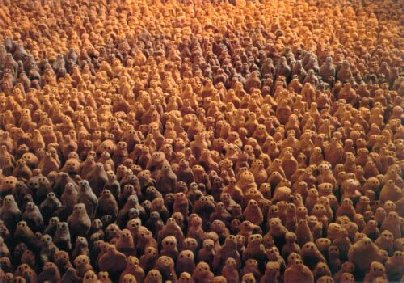One of the principal ways in which Antony Gormley creates art is by making casts of his own body. A chorus of proudly naked, life-size versions of the sculptor himself has assembled on the rooftops around the Hayward Gallery, where a retrospective of the sculptor’s work opened last week. Mute, life-sized figures, they wait and watch like mute sentinels, standing guard for reasons that remain mysterious. Some are cast in bronze, others in fibreglass, but the process of their making has blurred their features into masks of solemn inscrutability. A few have been placed on top of the Hayward Gallery itself, while others have been placed much further away – one distant figure has even been perched on the roof of the Freemason’s Hall, on the other side of waterloo Bridge. There is no hint of a common motivation, no suggestion of a narrative in which all might be actors. They are simply there, inertly occupying space. Their very inertness, in fact, may offer a clue to the artist’s intentions. They exist, primarily, as life-sized markers in space – prompting reflections on the small scale of the human body, any human body, within the large and busy world of the metropolis. Their collective title is Event Horizon, a pun perhaps on the way in which they conjure a kind of perceptual event from the
The human form has been Gormley’s chief preoccupation throughout his career, so he might be described as one of the few contemporary artists still working within the ancient traditions of figurative sculpture. Yet unlike more traditionally figurative artists, he seems notably uninterested in story, or action, or even the specifics of particular human emotions. He focusses instead on the shared aspects of physical experience, on what is common to all. Many of...


